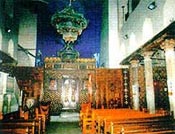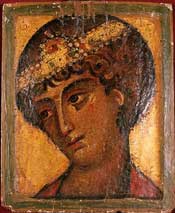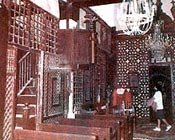|
Old Cairo Churches
Old Cairo is the historic link between Egypt’s pharaonic and
Islamic civilizations. Here, the fortress-town of Babylon, where
the Holy Family is thought to have taken refuge, developed into
a power house of native Christianity which today remains the
heart of Cairo’s Coptic community.
Old Cairo is also known as the district of the seven churches,
which are the Church of Abu Serga (Church of St Sergius), the
Hanging Church (Al Mo’allaqa Church), The Church of St Barbara,
The monastery of St George , The Greek Orthodox Church of St
George,The Church of St George (Church of Mari Guirguis) and the
Church of the Virgin .
Nestled between the Hanging Church and the Roman towers of
Babylon, The Coptic Museum is one of the highlights of Old
Cairo, which houses a rare collection of Christian antiquities.
• The Church of Abu Serga
 The church is dedicated to Sergius and Bacchus, who were
soldier-saints that were martyred during the 4th century in
Syria by Maximilan. The original building was probably built in
the 5th century. It burnt down during the fire of Fustat around
750 AD. It was restored during the 8th century, and has been
rebuilt and restored constantly since medieval times. It is said
to be an ideal model of the early Coptic churches. The Church of
Abu Serga retains the basilical form typical of early Coptic
churches. The low ceiling and the antique columns topped with
Corinthian capitals support the women’s gallery, where you can
inspect its thirteenth-century haikal screen and bits of
frescoes and mosaics in the central apse. It has 12 unique
columns decorated with paintings of the Apostles. This church
resembles religious structures in Constantinople and Rome. The
main attraction is the Steps to the right of the altar
descending into a crypt which contains the remains of the
original church where the Holy Family are believed to have
stayed. The church is dedicated to Sergius and Bacchus, who were
soldier-saints that were martyred during the 4th century in
Syria by Maximilan. The original building was probably built in
the 5th century. It burnt down during the fire of Fustat around
750 AD. It was restored during the 8th century, and has been
rebuilt and restored constantly since medieval times. It is said
to be an ideal model of the early Coptic churches. The Church of
Abu Serga retains the basilical form typical of early Coptic
churches. The low ceiling and the antique columns topped with
Corinthian capitals support the women’s gallery, where you can
inspect its thirteenth-century haikal screen and bits of
frescoes and mosaics in the central apse. It has 12 unique
columns decorated with paintings of the Apostles. This church
resembles religious structures in Constantinople and Rome. The
main attraction is the Steps to the right of the altar
descending into a crypt which contains the remains of the
original church where the Holy Family are believed to have
stayed.
• The Church of St Barbara
 It is one of the most beautiful Coptic Churches. The
eleven-century Church of St Barbara replaced an earlier Church
of SS. Cyrus and John, which was razed during Al-Hakim’s assault
on Fustat. Unlike others in the quarter, its wooden-vaulted roof
is lofty, with skylights and windows illuminating a nave flanked
by Arabic arches with Fatimid tie beams. The same goes for its
minbaresque pulpit and inlaid haikal. The right-hand wall
relates the life of Jesus in colorful tableaux, while the
western sanctuary contains the relics of St Barbara. Tradition
holds that she was the daughter of a pagan merchant who was
murdered for preaching Christianity in the third century. It is one of the most beautiful Coptic Churches. The
eleven-century Church of St Barbara replaced an earlier Church
of SS. Cyrus and John, which was razed during Al-Hakim’s assault
on Fustat. Unlike others in the quarter, its wooden-vaulted roof
is lofty, with skylights and windows illuminating a nave flanked
by Arabic arches with Fatimid tie beams. The same goes for its
minbaresque pulpit and inlaid haikal. The right-hand wall
relates the life of Jesus in colorful tableaux, while the
western sanctuary contains the relics of St Barbara. Tradition
holds that she was the daughter of a pagan merchant who was
murdered for preaching Christianity in the third century.
• The Hanging Church
 It was built over the remains of the southern gate of the Roman
Fortress of “Babylon”. Therefore it was called “the Hanging
Church” or Al Mu’allaqah. It was built over the remains of the southern gate of the Roman
Fortress of “Babylon”. Therefore it was called “the Hanging
Church” or Al Mu’allaqah.
The church was first built, in Basilcan style, in the 3rd or 4th
century. The main church is thought to have been built between
the 5th and 6th centuries with the southeastern section called
the "upper church" being added later. The church was destroyed
in the 9th century. It was rebuilt in the 11th century and
became the seat of the Coptic patriarch until the 14th century.
It became known to travelers during the 14th and 15th centuries
as the "staircase church" because of the twenty-nine steps that
lead to the entrance.
The main nave – whose ceiling is ribbed like an upturned boat or
Ark- is separated from its side aisles by sixteen pillars,
formerly painted with images of saints. Behind the marbel
pulpit, beautifully carved screens hide three haikals (altar
areas) from the congregation. Their star patterns are
accentuated by inlaid bone and ivory.
Among its relics, the Church owns an olive stone chewed by the
Virgin Mary , to whom El-Mu’allaqah is dedicated.
• The Monastery of St
George
 The monastery of St George is now the seat of the Greek Orthodox
Patriarchate of Alexandria. The main building of the monastery
is closed to visitors. But you can walk down into a lofty hall
once belonged to a Fatimid mansion and into the Chapel beyond,
with its tall, narrow wooden doors, which boasts a cedar wood
casket containing relics of St George. To the left of this
building is a small room for the “chain-wrapping ritual”,
sympolizing the saint’s persecution by the Romans. The monastery of St George is now the seat of the Greek Orthodox
Patriarchate of Alexandria. The main building of the monastery
is closed to visitors. But you can walk down into a lofty hall
once belonged to a Fatimid mansion and into the Chapel beyond,
with its tall, narrow wooden doors, which boasts a cedar wood
casket containing relics of St George. To the left of this
building is a small room for the “chain-wrapping ritual”,
sympolizing the saint’s persecution by the Romans.
• The Greek Orthodox
Church of St George
This Church is the only one in Egypt with round dome, its dark
interior is perfumed with incense and pierced by sunbeams
filtered through stained glass. A (barred) flight of steps
descends into the bowels of the Roman Tower. The present church
was built in 1904 after a fire destroyed the original
tenth-century structure
• The Church of St George
This church is founded in 681 by Athanasius the scribe. From the
original foundation only the Hall of Nuptials survived a
conflagration in the mid-nineteenth century, after which the
current structure was erected.
• The Church of the Virgin,
 This church is also identified by its alternative name of
Qasriet Al-Rihan (Basil Pot) after the favorite herb of the
Orthodox Church. Because Al-Hakim’s mother was of that faith ,
the church was given to the Greek community for the duration of
his reign, but later returned to the Copts. Largely rebuilt in
the eighteenth century, it’s chiefly notable for several icons
painted by John the Armenian in 1778. This church is also identified by its alternative name of
Qasriet Al-Rihan (Basil Pot) after the favorite herb of the
Orthodox Church. Because Al-Hakim’s mother was of that faith ,
the church was given to the Greek community for the duration of
his reign, but later returned to the Copts. Largely rebuilt in
the eighteenth century, it’s chiefly notable for several icons
painted by John the Armenian in 1778. |